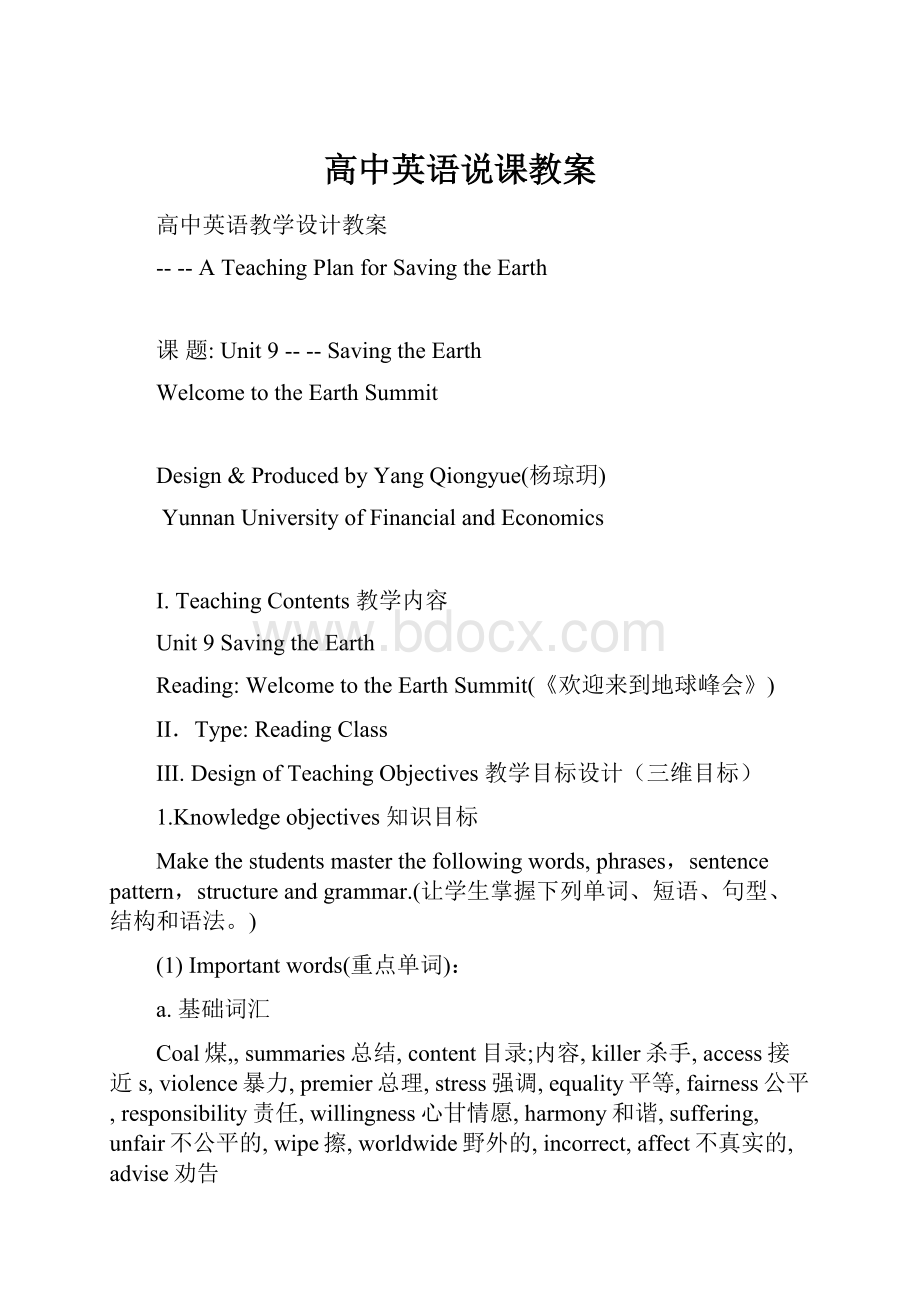高中英语说课教案.docx
《高中英语说课教案.docx》由会员分享,可在线阅读,更多相关《高中英语说课教案.docx(11页珍藏版)》请在冰豆网上搜索。

高中英语说课教案
高中英语教学设计教案
----ATeachingPlanforSavingtheEarth
课题:
Unit9----SavingtheEarth
WelcometotheEarthSummit
Design&ProducedbyYangQiongyue(杨琼玥)
YunnanUniversityofFinancialandEconomics
I.TeachingContents教学内容
Unit9SavingtheEarth
Reading:
WelcometotheEarthSummit(《欢迎来到地球峰会》)
II.Type:
ReadingClass
III.DesignofTeachingObjectives教学目标设计(三维目标)
1.Knowledgeobjectives知识目标
Makethestudentsmasterthefollowingwords,phrases,sentencepattern,structureandgrammar.(让学生掌握下列单词、短语、句型、结构和语法。
)
(1)Importantwords(重点单词):
a.基础词汇
Coal煤,,summaries总结,content目录;内容,killer杀手,access接近s,violence暴力,premier总理,stress强调,equality平等,fairness公平,responsibility责任,willingness心甘情愿,harmony和谐,suffering,unfair不公平的,wipe擦,worldwide野外的,incorrect,affect不真实的,advise劝告
b.认读词汇
Issue问题,environmentalist环境论者,Johannesburg约翰内斯堡,poverty贫困,SouthAfrica南非,car-pooling合伙用车,theWorldHealthOrganization(WHO)世界卫生组织
c.PointWords(关键词汇):
sustainable(可持续的),contaminated(受污染的),sanitation(公共卫生),especially(特别、尤其),cooperation(合作、协力)
(2)Importantphrases(重点词组):
TheUnitedNations联合国,takeaction采取行动,airconditioner空气调节器,inharmonywith与…….协调,wipeout消灭,putanendto结束,advisesb.(not)todosth劝某人(不)做某事,Sustainabledevelopment,WHO,haveaccessto,takeaction
(3)Importantsentencepattern(重点句型)
onlybydoing…,notuntil…,itwouldbebetterifwe…
(4)ImportantStructure(重点结构):
a.Fullinversion(倒装):
V+S
b.Partialinversion:
Aux/Mod+S+V
c.Predicative(表语)
Adverbial+as(though)+subject+...
verb
(5)GrammarAdded补充语法
一.倒装语序分为“全部倒装”和“部分倒装”。
在全部倒装的句子中,整个谓语都放在主语的前面;在部分倒装的句子中,只是谓语中的一部分(如助动词、情态动词或系动词be等)放在主语前面,其余部分仍放在主语后面。
一、由there,here或now等引起,谓语为come(或go)的句子,例如:
Therecomesthebus!
Theregoesthebell!
HerecomesMary!
Nowcomesyourturn.
注:
如果主语为人称代词,仍用自然语序,例如:
Therehecomes!
Hereshecomes!
二、由then引起,谓语为come(或follow)的句子,
Thencameanewdifficulty.
ThenfollowedeightyearsoftheAnti-JapaneseWar.
三、由here(或there)引导,谓语为be的句子
HereisChina’slargesttropicalforest.
Herearesomepicture-books.
注:
如果主语为人称代词,仍用自然语序,
Hereyouare./Hereweare./Hereitis
四、由so引起的,表示前面所说的情况也适用于另一个人(或物)的句子,如:
Societyhaschangedandsohavethepeopleinit.
Heplaystheviolinquitewell.Sodoesmysister.
如果一个句子只是重复前面一句话的意思,尽管so用开头,语序也不要倒装
--Itwascoldyesterday.–-Soitwas!
五、由neither或nor引起的,表示前面所说的情况也适用于另一个人(或物)的句子,
--Iwon’tdosuchathing.
–-Neither/NorwillI.
--Ihaven’tdonemyhomework.
–-Neither/NorhaveI.
Ifyoudon’tgo,neitherwillI.
Ididn’treadthenotice,nordidhe.
六、在if引导的非真实条件句中,如有助动词had,should或were时,可以省略if,进行倒装,
HadIcomefiveminutesearlier,Iwouldhavemetthefamousscientist.
(IfIhadcomefiveminutes…)
Shouldanyonecall,tellhimtowaitformehere.
七、out,in,up,down,away等副词放在主语前,主谓倒装
Upflewtheredballoon.
Outrushedapolicemanfromamongthecrowd.
注:
如果主语是一个人称代词,谓语仍放在后面,如:
Awaytheywent./Downitflew. / Upitwent.八、当as引导让步状语从句时,把表语提到前面来,用“形容词(或副词、名词+as+主语+谓语”这种形式
Childasheis,heknowsalot.
Tiredashewas,hecontinuedtowork.
八、当always,often,manyatime等词放在句首时,后面常用倒装语序,如:
Alwaysdidhecometohelpus.
Oftendidwewarnthemnottodoso.
注:
上述所说的词不放在句首,不用倒装语序。
九、only所修饰的副词、介词短语或状语从句放在句首时,其后面的主语部分要进行倒装,如:
Onlyinthiswaycanyouhopetoimprovethesituationthere.
OnlyyesterdaydidIrealizewhatwasgoingon.
OnlyafterhecamebackwasIabletoseehim.
注:
only修饰主语,仍用自然语序,如:
OnlysocialismcansaveChina.
十、含有否定意义的副词、连词或短语构成的状语放在句首时,常用倒装语序
not,never,hardly,seldom,little,rarely,
scarcely,notuntil,notonly…butalso…,
neither…nor…no sooner…than…,
hardly…when…,scarcely…when
NevershallIforgettheday.
NotuntilIbegantoworkdidIrealizeIhadwastedmuchtime.
Notonlydidhereadthebook,butalsoherememberedwhathehadread.
Nosoonerhadhearrivedthanhefellill.
Hardly/Scarcelyhadhearrivedwhenhefellill.
注:
上面所说的词和词组如果不在句首,句子不必用倒装语序。
另外,notonly…butalso连接两个主语时,不用倒装,如:
Notonlythestudents,butalsotheteacherwishesforaholiday.
十一、当so(或such)…that…结构中的so或such用于句首时,要采取倒装语序,如:
Soloudlydidhespeakthathewasheardupstairs.
Suchwastheforceoftheexplosionthatallthewindowswerebroken.
注:
such和be连用作表语时,也常用倒装语序,
Suchwastheresult.
Suchwereherwords.
十二、在下列结构中也常用倒装语序:
Infrontofthemstoodagreatcastle.
Onthebedlayasickoldman.
2.Abilityobjective能力目标
Improvethestudents’readingabilityandEnglishapplicationabilitiesthroughreadingactivities.Toimprovestudents’speakingabilitybypracticesupportinganopinion.(通过系列阅读活动提高学生的阅读理解能力和英语应用能力。
通过对支持某观点方面的联系,提高学生的口语能力。
)
3.Affectiveobjectives情感价值目标
AfterLearningthepassage,thestudentsareexpectedtoknowtheserioussituationoftheearthandknowsomethingabouttheEarthSummit.Toarousestudentstothinkabouttheproblemstheearthisfacingbytalkingaboutnature,ecologyandenvironment.Makestudentstakepartintheactivitiesofprotectiontheearth.
(通过本节课的学习,让学生了解地球现状的严峻,并对地球峰会有所了解。
引发学生对地球面临的自然、生态和环境问题的思考。
鼓励他们积极参与到保护地球的活动当中。
)
IV.TeachingImportantPoints(教学重点)
1.Learnthewordsandphraseslistedabove.
(学习上列单词和短语。
)
2.Enablethestudentstoimprovetheirreadingcomprehension.(提高学生的阅读理解能力。
)
3.Enablethestudentstopracticetheirpragmaticcompetenceandcommunicationskills.(锻炼学生的语用能力和交流能力)
V.TeachingDifficultPoints(教学难点)
1.Understandthefollowingsentencecorrectly.(正确理解下面句子。
)
Withoutinternationalcooperation,developingcountriescannotproper,norwillsustainabledevelopmentbepossible.
Onlybychangingthewaywelivecanwesavetheearth.
2.Howtohelpthestudentsunderstandthepassagebetter.
(怎样帮助学生更好地理解这篇课文?
)
VI.TeachingMethods(教学方法)
1.Task-basedmethodtomakestudentsinterestedinwhattheywilllearn.(任务型教学法)
2.Fastreadingtogetthegeneralideaofthepassage.(略读法)
3.Carefulreadingtogetsomedetailedinformation.(细读法)
4.CommutativeApproach(交际教学法)
5.Pairworkorindividualroleplayorsceneplayactivity(成对练习或角色扮演或场景演练)
VII.TeachingAids:
(教学辅助手段)
1.Ablackboard(黑板)
2.Atape-recorder(收音机)
3.Aprojectorandacomputerformultimedia(投影仪、多媒体)
Ⅷ.Teachingprocedures(教学程序)
StepILeadin(3minutes)(引入,3分钟)
教师活动:
呈现多幅显现地球环境污染的图片给学生观察。
学生活动:
Describewhatyouseeinthepicture.
(描述你在图片中所看到的。
)
设计目的:
激发学生的学习兴趣,让学生主动参与。
StepIIpre-reading(3minutes)(读前,3分钟)
TodaywecometotheReading.It’sabouttheEarthSummit.WhatisaEarthSummit?
What’stheenvironmentliketoday?
Whatcanwedoinourdailylife?
Throughthisreadingmaterial,wecanrealizetheEarthSummit’sfunctionandknowhowtoprotecttheearth.
教师活动:
老师问学生HaveyouheardabouttheEarthSummit?
WhatdoyouthinkaEarthSummitis?
Doyoudosomethingtoprotecttheenvirnment?
(你听说过地球峰会吗?
你认为什么是地球峰会?
在你的生活中,你为保护地球做出过贡献吗?
)
学生活动:
学生分组把自己的想法汇报给组员。
设计意图:
(1)激活学生已有的信息,使学生具备摄入新知识的心理定势。
(2)激发学生的学习兴趣。
(3)帮助老师引入课文的主题。
StepIII.While-reading(14minutes)(阅读,14分钟)
1.Fastreading(4minutes)(快速阅读,4分钟)
Askthestudentstoreadthepassagequicklyandmatchtheparagraphswiththemainideas(Onthescreen).
教师活动:
教师用投影仪展示出下面问题:
Paragraph1-2What’sthe1972’summit’saim?
Paragraph3-6What’stheconditiontoachievethesustainabledevelopment?
Paragraph7What’sthekeytothefuture?
学生活动:
学生快速浏览课文,了解课文大意。
设计意图:
训练学生快速阅读,归纳各段落的中心意思的能力。
(Skimmingforthemainidea)
2.Carefulreading(10minutes)(细读,10分钟)
(1)教师活动:
要求学生认真阅读课文,寻找相关信息:
1Whatarethe“bigthree”?
Doyouknowanyothermajorproblemsfacingtheearth?
2WhyareconferencesliketheEarthSummitimportant?
3WhichoftheissuediscussedattheEarthSummitdoyouthinkisthemostimportant?
Why?
学生活动:
认真阅读课文完成任务,然后向全班汇报。
设计意图:
训练学生快速查读细节、捕捉信息的能力。
(Scanningfordetailedinformation)
(2)教师活动:
用多媒体展示课后语言点习题,并让学生根据所阅读的文章当堂完成习题。
学生活动:
在老师出示习题之后,在短时间的浏览题目,不参考课本的前提下完成习题。
可以不必参照课本原文词汇回答。
设计意图:
训练学生对文章的理解能力及词汇转换能力。
StepIVPost-reading(6minutes)(读后,6分钟)
教师活动:
教师展示一些具有归纳总结性的问题:
①WhydoestheUNholdtheEarthSummit?
②Whatwerethesolutionssuggestedinthe1972’summit?
③Whatdoyoulearnfromthesummit?
What’syoursuggestionsfortheprotectionoftheenvironmen?
学生活动:
学生思考并讨论上述问题,然后向全班同学汇报。
设计意图:
①帮助学生进行课堂反思,自己学到了些什么知识;
②学生收集课文中没有解决的问题,以便课后进一步讨论。
StepVLanguagestudy(7minutes)(语言学习,7分钟)
Therearesomeusefulwordsandexpressionsthestudeutsshouldlearntouseinthepassage:
(本课中学生应学会使用的单词和习惯表达:
)
①sustainable
②contaminated
③sanitation
④especially
⑤cooperation
⑥haveaccessto
⑦takeaction
⑧inharmonywith
⑨putanendto
StepVILiteningandConsolidation(4minutes听课文,4分钟)
Playthetapeforthestudentstolistenandfollow.Payattentiontothepronunciationantintonation.
教师活动:
教师放课文录音带
学生活动:
学生小声跟读课文,并注意语音语调。
设计意图:
让学生更进一步巩固课文内容,并训练其语音语调。
StepVIIDiscussionandHomework(3minutes)(讨论和作业布置,3分钟)
1、Writedownthemainideaofeachparagraph.
2、Makeaconclusionforthearticleinyourownwords.
Ⅸ、TheDesignoftheWritingontheBlackboard(板书设计)
Unit9SavingtheEarth
Reading:
WelcometotheEarthSummit
Verbs:
1.that
Makesure
todo
Phrases:
1.haveaccessto
2.takeaction
3.inharmonywith
4.putanendto
Sentencepattern:
Without…nor…
Onlybydoing…canwe…
Ⅹ、教学目标达成的思路:
1、教学流程:
2、师生互动:
教师活动:
学生活动: